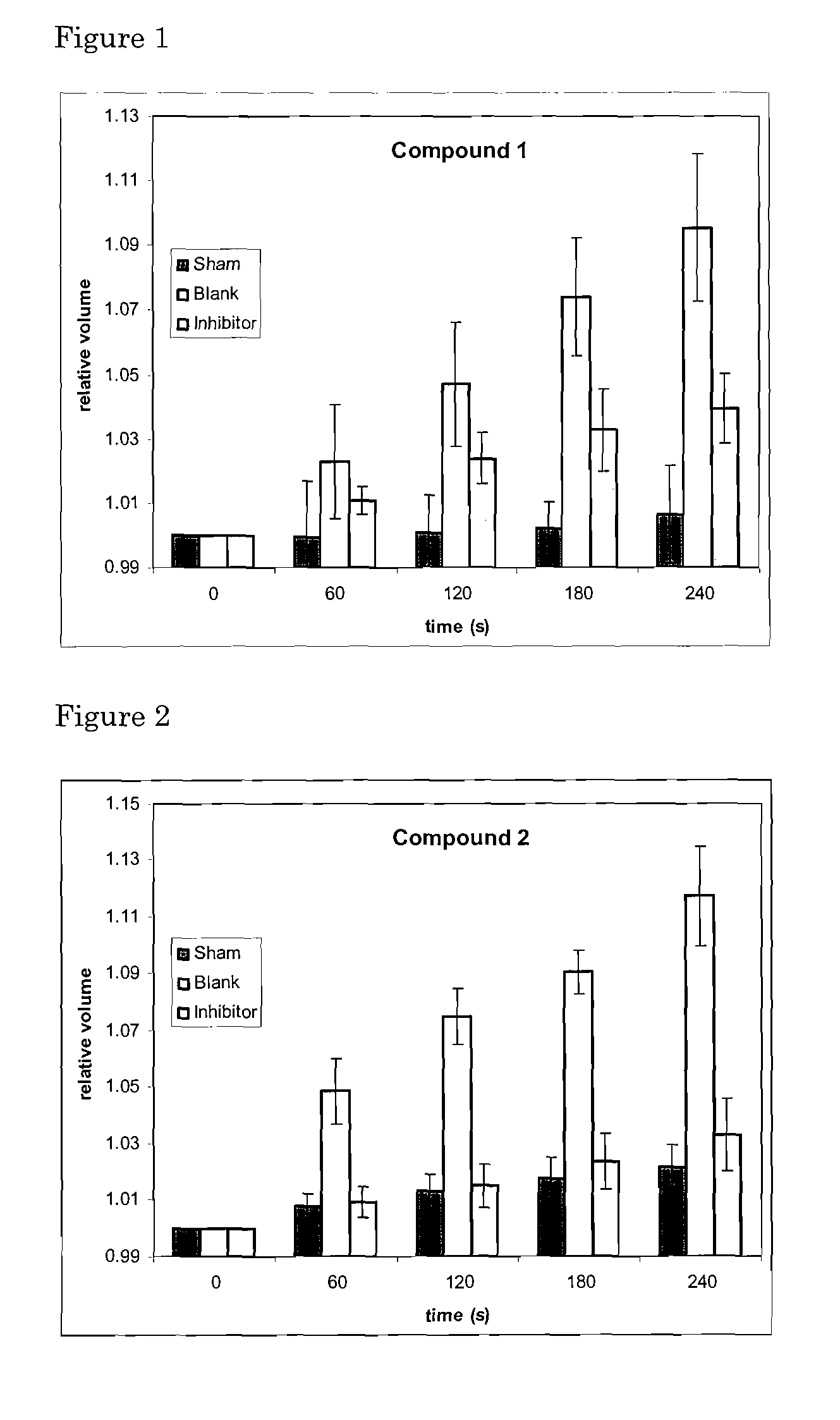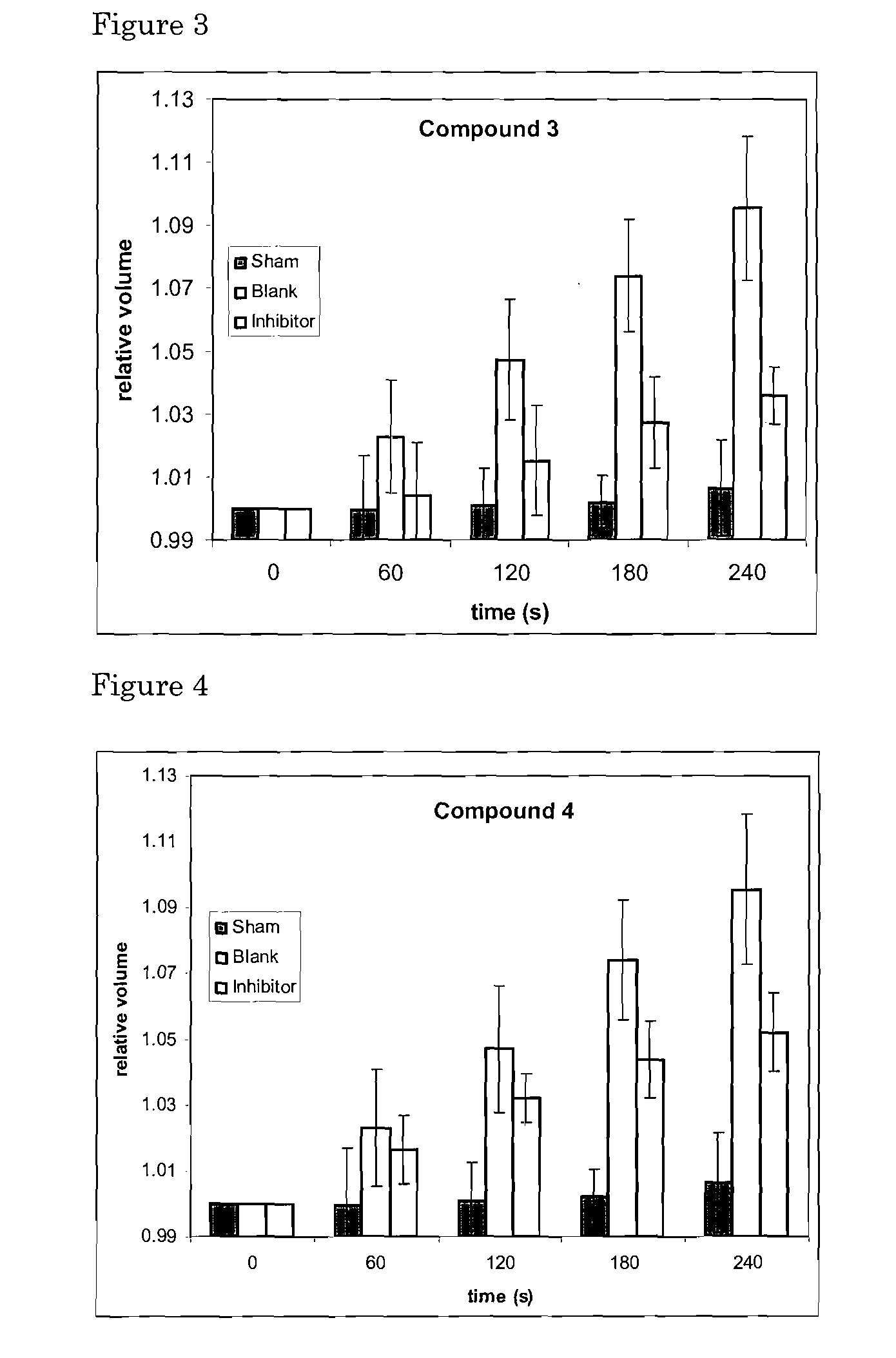Inhibitors of aquaporin 4, methods and uses thereof
- Summary
- Abstract
- Description
- Claims
- Application Information
AI Technical Summary
Benefits of technology
Problems solved by technology
Method used
Image
Examples
example 1
[0069]This Example 1 concerns organic chemical agents of synthetic or natural origin, or a combination thereof, and their pharmaceutically relevant salts and derivatives as inhibitory modulators of the AQP4 protein and its transmembrane water transport properties. Such molecular agents can have a variety of uses in medicine, pharmacology and drug discovery.
[0070]In this example, there is further proposed the class of organic molecules and their pharmaceutically acceptable salts wherein they may be described by the following schematic diagram:
R—Ar—SO2NH2
[0071]Within the context of this example, Ar may be described as a 5- or 6-membered aromatic group that may contain nitrogen, oxygen or sulfur, in addition to carbon and hydrogen atoms. Ar can also be described as a 6,6-, 5,6- or 6,5-fused bicyclic aromatic group that may contain nitrogen, oxygen and sulfur, in addition to carbon and hydrogen atoms. Preferred in this example is the relative distribution of the R and sulfonamide group...
example 3
[0074]As a further embodiment of Example 1, we propose the class of organic molecules and their pharmaceutically acceptable salts wherein they may be described by the following schematic diagram:
[0075]Within the context of this example, Ar may be described as a 5- or 6-membered aromatic group that may contain nitrogen, oxygen or sulfur, in addition to carbon and hydrogen atoms. Ar can also be described as being a 6,6-, 5,6- or 6,5-fused bicyclic aromatic group that may contain nitrogen, oxygen and sulfur, in addition to carbon and hydrogen atoms. Preferred in this example are Ar groups that contain one or more ring nitrogen atoms that can not be described as being —NH— or —NH2+—. As examples of the types of groups preferred within the context of this example, the Ar group can then be described as being selected from but not limited to the following list: 3-substituted pyridine; 2-substituted pyrazine; 5-substituted pyrimidine; 2-substituted oxazole; 5-substituted oxazole; 2-substitu...
example 4
[0078]As a further embodiment of Example 1, we propose the class of organic molecules and their pharmaceutically acceptable salts wherein they may be described by the following schematic diagram:
R—X—Ar
[0079]Within the context of this example, Ar may be described as being a 5- or 6-membered aromatic group that may contain nitrogen, oxygen or sulfur, in addition to carbon and hydrogen atoms. Ar may also be described as being a 6,6-, 5,6- or 6,5-fused bicyclic aromatic group that may contain nitrogen, oxygen and sulfur, in addition to carbon and hydrogen atoms. Preferred in this example are Ar groups that contain one or more ring nitrogen atoms that can not be described as being —NH— or —NH2+—. As examples of the types of groups preferred within the context of this embodiment of the example, the Ar group can then be described as being selected from but not limited to the following list: 3-substituted pyridine; 2-substituted pyrazine; 5-substituted pyrimidine; 2-substituted oxazole; 5-s...
PUM
| Property | Measurement | Unit |
|---|---|---|
| Fraction | aaaaa | aaaaa |
| Transport properties | aaaaa | aaaaa |
| Inhibition | aaaaa | aaaaa |
Abstract
Description
Claims
Application Information
 Login to View More
Login to View More - R&D Engineer
- R&D Manager
- IP Professional
- Industry Leading Data Capabilities
- Powerful AI technology
- Patent DNA Extraction
Browse by: Latest US Patents, China's latest patents, Technical Efficacy Thesaurus, Application Domain, Technology Topic, Popular Technical Reports.
© 2024 PatSnap. All rights reserved.Legal|Privacy policy|Modern Slavery Act Transparency Statement|Sitemap|About US| Contact US: help@patsnap.com










